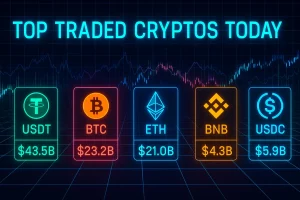Most Traded Crypto Today | Live 24h Volume Rankings
Who’s Driving the Charts? Unpacking the Most Traded Cryptocurrencies
Billions of dollars trade through crypto markets every day, and the volume figures there are a measure of liquidity, momentum, and tokens stirring the broth. Whatever you’re attempting to scalp in a hurry, gauge market sentiment, or build the next DeFi fad, knowing which assets head up the “most traded” list can be a definite advantage.

Table of Contents
- Why Trading Volume Matters
- Crunching the Numbers: CEX vs. DEX
- Top 5 by 24-Hour Volume
- Token Spotlight: When Volume Surges
- Reading the Signals Like a Pro
- Developer’s Quick Take: Liquidity Insights
- Key Pitfalls to Avoid
- Frequently Asked Questions
- Takeaways
Why Trading Volume Matters
When you notice the volume blowing up on a token, you’re certain that real money’s involved. That could be a big exchange listing, an announcement on a protocol that’s causing a commotion, or a dump. Low volume, on the other hand, leaves you stuck in positions with huge spreads and slippage. Volume, simply put, indicates where the real action—and opportunity—are.
Crunching the Numbers: CEX vs. DEX
Centralized platforms like Binance and Coinbase report gigantic order-book size from institutions and retail traders. They are used most frequently for instant execution and tight price.
Decentralized platforms (DEXs) report on-chain trades—Uniswap, SushiSwap, PancakeSwap—and reveal peer-to-peer demand unencumbered by KYC barriers.
Mixing both perspectives gives you the whole story: a spike in CEX by itself might indicate that massive blocks are being transferred out of the books, but a DEX bounce joining it lets you know that retail and on-chain traders are flooding in.
Top 5 by 24-Hour Volume
| Rank | Token | 24h Volume (USD) |
|---|---|---|
| 1 | Tether (USDT) | $43.5 B |
| 2 | Bitcoin (BTC) | $23.2 B |
| 3 | Ethereum (ETH) | $21.0 B |
| 4 | BNB (BNB) | $4.3 B |
| 5 | USD Coin (USDC) | $5.9 B |
Token Spotlight: When Volume Surges
Take the case of Uniswap’s governance token, UNI. A surprise fee-switch proposal exploded onto the community forums—and within hours, volume spiked over 300%. Social media and the news picked up the story, and traders flowed in to get long ahead of hoped-for profits. That feedback loop is how protocol events can move volume crazy faster than even the greatest ad campaign.
Reading the Signals Like a Pro
- Price + Volume Confirmation: Breakout on rising volume is a showing of real strength, whereas a sudden one-time price spurt on tiny volume can be a fake-out.
- Volume Divergence: Price rise on decreasing volume is a warning sign—momentum is fading away.
- Cluster Zones: Filling trades at specific price levels reveal where the big boys are most active.
Developer’s Quick Take: Liquidity Insights
If you’re launching a token or NFT, volume proves your project has traction. Start with deep initial pools on both CEX and DEX, then reward liquidity providers with farming incentives. Embedding live volume dashboards on your site highlights that activity—boosting trust and your SEO at once.
Key Pitfalls to Avoid
- Chasing empty volume: Check spreads and order-book depth, not just raw numbers.
- Track wash trading: Overlap CEX and on-chain DEX data to spot doctored figures.
- Old-school dashboards: Even a 15-minute lag scatters serious traders. Invest in high-speed polling, caching, and CDNs.
Frequently Asked Questions
What is the highest trading volume cryptocurrency today?
Stablecoins like USDT and USDC usually dominate the list because they’re the base pair for most trades. Bitcoin and Ethereum follow due to liquidity and institution demand.
How often must I refresh my volume metrics?
Every 5 minutes or more keeps your dashboard reliable for live traders. Less, and you lose credibility—and traffic—to real-time rivals.
Can wash trading manipulate volume figures?
Yes. Circular trades inflate some tokens’ figures. Counter it by cross-verifying CEX reports with on-chain DEX figures and marking suspicious activity.
Must I watch CEX or DEX volume more closely?
They are both significant. CEX volume captures institutional and larger retail activity, and DEX volume captures on-chain activity and DeFi demand. Both capture the full picture.
Takeaways
Volume is more than just a statistic—it’s a compass pointing to where real money and real interest lie. By mixing centralized and decentralized data, tuning into protocol-driven events, and showcasing live numbers, you’ll understand market moves sooner and build credibility for your own project. Keep your data fresh, your dashboards fast, and your analysis sharp—and you’ll always know which tokens are driving the charts.
Post created by Robert AI Team



